Model-Based Fault Diagnosis Techniques
Series Editors' Foreword
Preface
Contents
Notation
Part I: Introduction, Basic Concepts and Preliminaries
Chapter 1: Introduction
1.1 Basic Concepts of Fault Diagnosis Technique
1.2 Historical Development and Some Relevant Issues
1.3 Notes and References
Chapter 2: Basic Ideas, Major Issues and Tools in the Observer-Based FDI Framework
2.1 On the Observer-Based Residual Generator Framework
2.2 Unknown Input Decoupling and Fault Isolation Issues
2.3 Robustness Issues in the Observer-Based FDI Framework
2.4 On the Parity Space FDI Framework
2.5 Residual Evaluation and Threshold Computation
2.6 FDI System Synthesis and Design
2.7 Notes and References
Chapter 3: Modelling of Technical Systems
3.1 Description of Nominal System Behavior
3.2 Coprime Factorization Technique
3.3 Representations of Systems with Disturbances
3.4 Representations of System Models with Model Uncertainties
3.5 Modelling of Faults
3.6 Modelling of Faults in Closed-Loop Feedback Control Systems
3.7 Case Study and Application Examples
3.7.1 Speed Control of a DC Motor
Model of DC Motor
Models of DC Motor Control System
Modelling of Faults
3.7.2 Inverted Pendulum Control System
Nonlinear System Model
Disturbances
Linear Model
Discrete-Time Model
LCF of the Nominal Model
Model Uncertainty
Modelling of Faults
Closed-Loop Model
3.7.3 Three-Tank System
Nonlinear Model
Linear Model
Model Uncertainty
Modelling of Faults
Closed-Loop Model
3.7.4 Vehicle Lateral Dynamic System
Nominal Model
Disturbances
Model Uncertainties
Modelling of Faults
3.7.5 Continuous Stirred Tank Heater
System Dynamics and Nonlinear Model
Linear Model
Model Uncertainties and Unknown Inputs
Modelling of Faults
3.8 Notes and References
Chapter 4: Fault Detectability, Isolability and Identifiability
4.1 Fault Detectability
4.2 Excitations and Detection of Multiplicative Faults
4.3 Fault Isolability
4.3.1 Concept of System Fault Isolability
4.3.2 Fault Isolability Conditions
4.4 Fault Identifiability
4.5 Notes and References
Part II: Residual Generation
Chapter 5: Basic Residual Generation Methods
5.1 Analytical Redundancy
5.2 Residuals and Parameterization of Residual Generators
5.3 Issues Related to Residual Generator Design and Implementation
5.4 Fault Detection Filter
5.5 Diagnostic Observer Scheme
5.5.1 Construction of Diagnostic Observer-Based Residual Generators
5.5.2 Characterization of Solutions
5.5.3 A Numerical Approach
5.5.4 An Algebraic Approach
5.6 Parity Space Approach
5.6.1 Construction of Parity Relation Based Residual Generators
5.6.2 Characterization of Parity Space
5.6.3 Examples
5.7 Interconnections, Comparison and Some Remarks
5.7.1 Parity Space Approach and Diagnostic Observer
5.7.2 Diagnostic Observer and Residual Generator of General Form
5.7.3 Applications of the Interconnections and Some Remarks
5.7.4 Examples
5.8 Notes and References
Chapter 6: Perfect Unknown Input Decoupling
6.1 Problem Formulation
6.2 Existence Conditions of PUIDP
6.2.1 A General Existence Condition
6.2.2 A Check Condition via Rosenbrock System Matrix
6.2.3 An Algebraic Check Condition
6.3 A Frequency Domain Approach
6.4 UIFDF Design
6.4.1 The Eigenstructure Assignment Approach
6.4.2 Geometric Approach
6.5 UIDO Design
6.5.1 An Algebraic Approach
6.5.2 Unknown Input Observer Approach
6.5.3 A Matrix Pencil Approach to the UIDO Design
6.5.4 A Numerical Approach to the UIDO Design
6.6 Unknown Input Parity Space Approach
6.7 An Alternative Scheme-Null Matrix Approach
6.8 Discussion
6.9 Minimum Order Residual Generator
6.9.1 Minimum Order Residual Generator Design by Geometric Approach
6.9.2 An Alternative Solution
6.10 Notes and References
Chapter 7: Residual Generation with Enhanced Robustness Against Unknown Inputs
7.1 Mathematical and Control Theoretical Preliminaries
7.1.1 Signal Norms
L2 ( l2 ) Norm
Peak Norm
2 (Euclidean) Norm
infty Norm
7.1.2 System Norms
Hinfty Norm
Peak-to-Peak Gain
Generalized H2 Norm
H2 Norm
Matrix Norm Induced by the 2 Norm for Vectors
Frobenius-Norm
infty Norm
7.1.3 Computation of H2 and Hinfty Norms
7.1.4 Singular Value Decomposition (SVD)
7.1.5 Co-Inner-Outer Factorization
7.1.6 Model Matching Problem
7.1.7 Essentials of the LMI Technique
7.2 Kalman Filter Based Residual Generation
Recursive Computation for Optimal State Estimation
Recursive Computation for Kalman Filter Gain
7.3 Robustness, Fault Sensitivity and Performance Indices
7.3.1 Robustness and Sensitivity
7.3.2 Performance Indices: Robustness vs. Sensitivity
7.3.3 Relations Between the Performance Indices
7.4 Optimal Selection of Parity Matrices and Vectors
7.4.1 Sf,+/Rd as Performance Index
7.4.2 Sf,-/Rd as Performance Index
7.4.3 JS-R as Performance Index
7.4.4 Optimization Performance and System Order
7.4.5 Summary and Some Remarks
7.5 Hinfty Optimal Fault Identification Scheme
7.6 H2/H2 Design of Residual Generators
7.7 Relationship Between H2/H2 Design and Optimal Selection of Parity Vectors
7.8 LMI Aided Design of FDF
7.8.1 H2 to H2 Trade-off Design of FDF
7.8.2 On the H- Index
7.8.3 H2 to H- Trade-off Design of FDF
7.8.4 Hinfty to H- Trade-off Design of FDF
7.8.5 Hinfty to H- Trade-off Design of FDF in a Finite Frequency Range
7.8.6 An Alternative Hinfty to H- Trade-off Design of FDF
7.8.7 A Brief Summary and Discussion
7.9 The Unified Solution
7.9.1 Hi/Hinfty Index and Problem Formulation
7.9.2 Hi/Hinfty Optimal Design of FDF: The Standard Form
7.9.3 Discrete-Time Version of the Unified Solution
7.9.4 A Generalized Interpretation
7.10 The General Form of the Unified Solution
7.10.1 Extended CIOF
7.10.2 Generalization of the Unified Solution
7.11 Notes and References
Chapter 8: Residual Generation with Enhanced Robustness Against Model Uncertainties
8.1 Preliminaries
8.1.1 LMI Aided Computation for System Bounds
8.1.2 Stability of Stochastically Uncertain Systems
8.2 Transforming Model Uncertainties into Unknown Inputs
8.3 Reference Model Based Strategies
8.3.1 The Basic Idea
8.3.2 A Reference Model Based Solution for Systems with Norm-Bounded Uncertainties
8.4 Residual Generation for Systems with Polytopic Uncertainties
8.4.1 The Reference Model Scheme Based Scheme
8.4.2 H- to Hinfty Design Formulation
8.5 Residual Generation for Stochastically Uncertain Systems
8.5.1 System Dynamics and Statistical Properties
8.5.2 Basic Idea and Problem Formulation
8.5.3 An LMI Solution
8.5.4 An Alternative Approach
8.6 Notes and References
Part III: Residual Evaluation and Threshold Computation
Chapter 9: Norm-Based Residual Evaluation and Threshold Computation
9.1 Preliminaries
9.2 Basic Concepts
9.3 Some Standard Evaluation Functions
Peak Value
RMS Value
9.4 Basic Ideas of Threshold Setting and Problem Formulation
9.4.1 Dynamics of the Residual Generator
9.4.2 Definitions of Thresholds and Problem Formulation
9.5 Computation of Jth,RMS,2
9.5.1 Computation of Jth,RMS,2 for the Systems with the Norm-Bounded Uncertainty
9.5.2 Computation of Jth,RMS,2 for the Systems with the Polytopic Uncertainty
9.6 Computation of Jth,peak,peak
9.6.1 Computation of Jth,peak,peak for the Systems with the Norm-Bounded Uncertainty
9.6.2 Computation of Jth,peak,peak for the Systems with the Polytopic Uncertainty
9.7 Computation of Jth,peak,2
9.7.1 Computation of Jth,peak,2 for the Systems with the Norm-Bounded Uncertainty
9.7.2 Computation of Jth,peak,2 for the Systems with the Polytopic Uncertainty
9.8 Threshold Generator
9.9 Notes and References
Chapter 10: Statistical Methods Based Residual Evaluation and Threshold Setting
10.1 Introduction
10.2 Elementary Statistical Methods
10.2.1 Basic Hypothesis Test
10.2.2 Likelihood Ratio and Generalized Likelihood Ratio
Detection when theta1 (>0) Is Known and theta0=0
Detection when theta1 Is Unknown and theta0=0
10.2.3 Vector-Valued GLR
10.2.4 Detection of Change in Variance
Testing with the chi2 Statistic Given by Lapin
Testing Using GLR Given by Basseville and Nikiforov
10.2.5 Aspects of On-Line Realization
On-Line Implementation with a Fixed Sample Size N
On-Line Implementation in a Recursive Manner
Setting a Counter
10.3 Criteria for Threshold Computation
10.3.1 The Neyman-Pearson Criterion
10.3.2 Maximum a Posteriori Probability (MAP) Criterion
10.3.3 Bayes' Criterion
10.3.4 Some Remarks
10.4 Application of GLR Testing Methods
10.4.1 Kalman Filter Based Fault Detection
10.4.2 Parity Space Based Fault Detection
10.5 Notes and References
Chapter 11: Integration of Norm-Based and Statistical Methods
11.1 Residual Evaluation in Stochastic Systems with Deterministic Disturbances
11.1.1 Residual Generation
11.1.2 Problem Formulation
11.1.3 GLR Solutions
11.1.4 An Example
11.2 Residual Evaluation Scheme for Stochastically Uncertain Systems
11.2.1 Problem Formulation
11.2.2 Solution and Design Algorithms
11.3 Probabilistic Robustness Technique Aided Threshold Computation
11.3.1 Problem Formulation
11.3.2 Outline of the Basic Idea
11.3.3 LMIs Used for the Solutions
11.3.4 Problem Solutions in the Probabilistic Framework
11.3.5 An Application Example
The Sample Size N
11.3.6 Concluding Remarks
11.4 Notes and References
Part IV: Fault Detection, Isolation and Identification Schemes
Chapter 12: Integrated Design of Fault Detection Systems
12.1 FAR and FDR
12.2 Maximization of Fault Detectability by a Given FAR
12.2.1 Problem Formulation
Problem of Maximizing SDF Under a Given FAR (PMax-SDF)
12.2.2 Essential Form of the Solution
12.2.3 A General Solution
12.2.4 Interconnections and Comparison
Relationship to the PUIDP
Relationship to H2/H2 Optimal Design Scheme
Relationship to Hinfty/Hinfty and H-/Hinfty Optimal Schemes
12.2.5 Examples
12.3 Minimizing False Alarm Number by a Given FDR
12.3.1 Problem Formulation
Problem of Minimizing SDFA Under a Given FDR (PMin-SDFA)
12.3.2 Essential Form of the Solution
12.3.3 The State Space Form
12.3.4 The Extended Form
12.3.5 Interpretation of the Solutions and Discussion
12.3.6 An Example
12.4 On the Application to Stochastic Systems
12.4.1 Application to Maximizing FDR by a Given FAR
12.4.2 Application to Minimizing FAR by a Given FDR
12.4.3 Equivalence Between the Kalman Filter Scheme and the Unified Solution
12.5 Notes and References
Chapter 13: Fault Isolation Schemes
13.1 Essentials
13.1.1 Existence Conditions for a Perfect Fault Isolation
13.1.2 PFIs and Unknown Input Decoupling
13.1.3 PFIs with Unknown Input Decoupling (PFIUID)
13.2 Fault Isolation Filter Design
13.2.1 A Design Approach Based on the Duality to Decoupling Control
13.2.2 The Geometric Approach
13.2.3 A Generalized Design Approach
13.3 An Algebraic Approach to Fault Isolation
13.4 Fault Isolation Using a Bank of Residual Generators
13.4.1 The Dedicated Observer Scheme (DOS)
13.4.2 The Generalized Observer Scheme (GOS)
13.5 Notes and References
Chapter 14: Fault Identification Schemes
14.1 Fault Identification Filter Schemes and Perfect Fault Identification
14.1.1 Fault Detection Filters and Existence Conditions
14.1.2 FIF Design with Measurement Derivatives
14.2 On the Optimal FIF Design
14.2.1 Problem Formulation and Solution Study
14.2.2 Study on the Role of the Weighting Matrix
14.3 Approaches to the Design of FIF
14.3.1 A General Fault Identification Scheme
14.3.2 An Alternative Scheme
14.3.3 Identification of the Size of a Fault
14.3.4 Fault Identification in a Finite Frequency Range
14.4 Fault Identification Using an Augmented Observer
14.5 An Algebraic Fault Identification Scheme
14.6 Adaptive Observer-Based Fault Identification
14.6.1 Problem Formulation
14.6.2 The Adaptive Observer Scheme
Observer
Auxiliary Filter
Fault Estimator
14.7 Notes and References
Chapter 15: Fault Diagnosis in Feedback Control Systems and Fault-Tolerant Architecture
15.1 Plant and Control Loop Models, Controller and Observer Parameterizations
15.1.1 Plant and Control Loop Models
15.1.2 Parameterization of Stabilizing Controllers, Observers, and an Alternative Formulation of Controller Design
15.1.3 Observer and Residual Generator Based Realizations of Youla Parameterization
15.1.4 Residual Generation Based Formulation of Controller Design Problem
15.2 Residual Extraction in the Standard Feedback Control Loop and a Fault Detection Scheme
15.2.1 Signals at the Access Points in the Control Loop
15.2.2 A Fault Detection Scheme Based on Extraction of Residual Signals
15.3 2-DOF Control Structures and Residual Access
15.3.1 The Standard 2-DOF Control Structures
15.3.2 An Alternative 2-DOF Control Structure with Residual Access
15.4 On Residual Access in the IMC and Residual Generator Based Control Structures
15.4.1 An Extended IMC Structure with an Integrated Residual Access
15.4.2 A Residual Generator Based Feedback Control Loop
15.5 Notes and References
References
Index
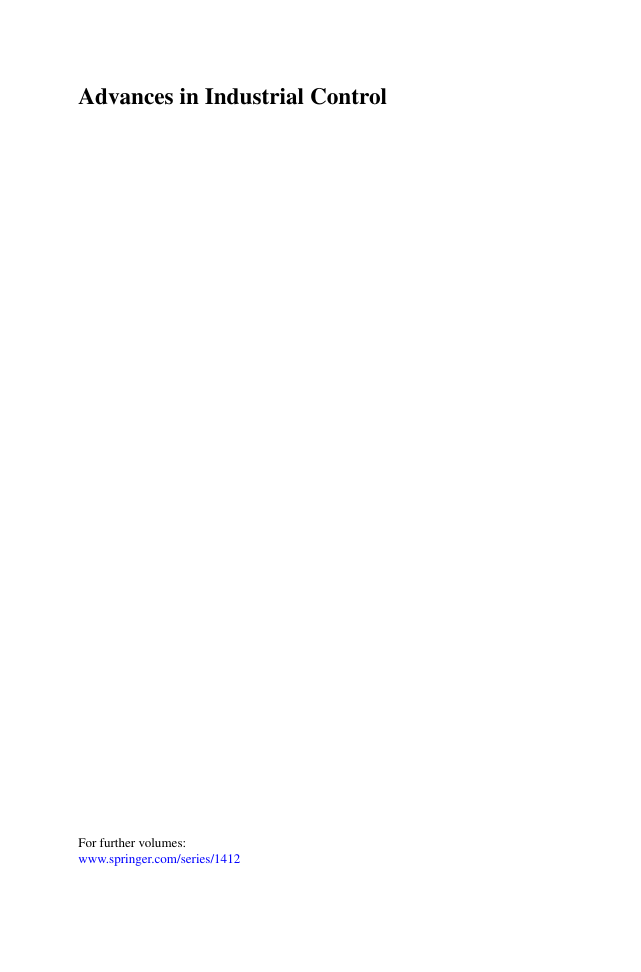

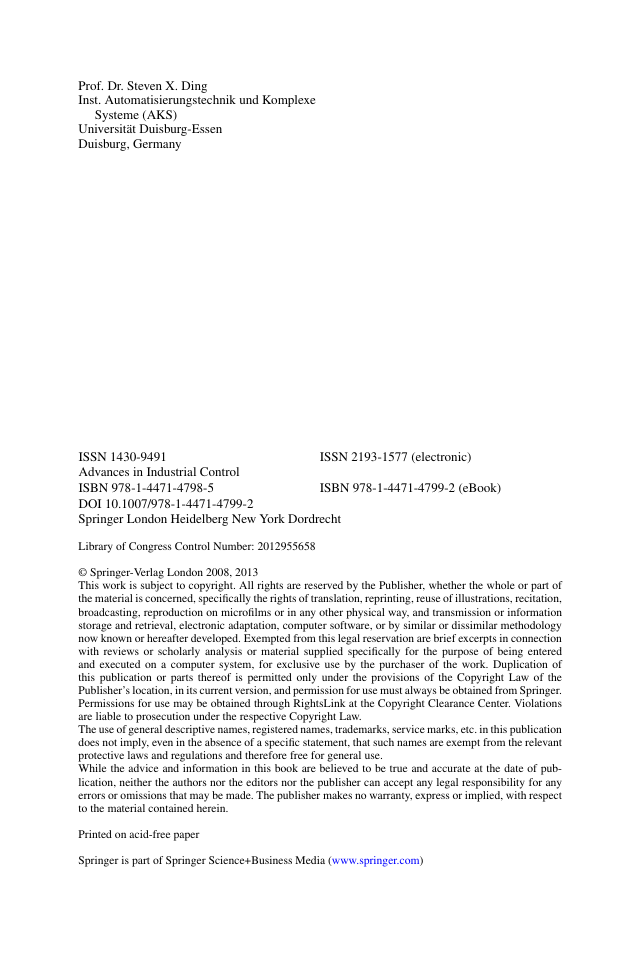

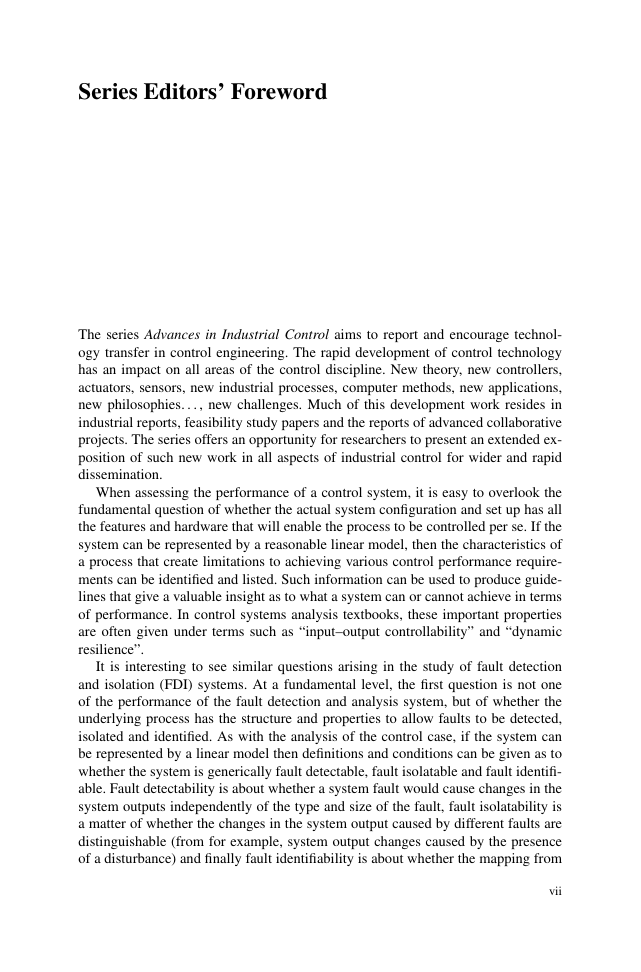
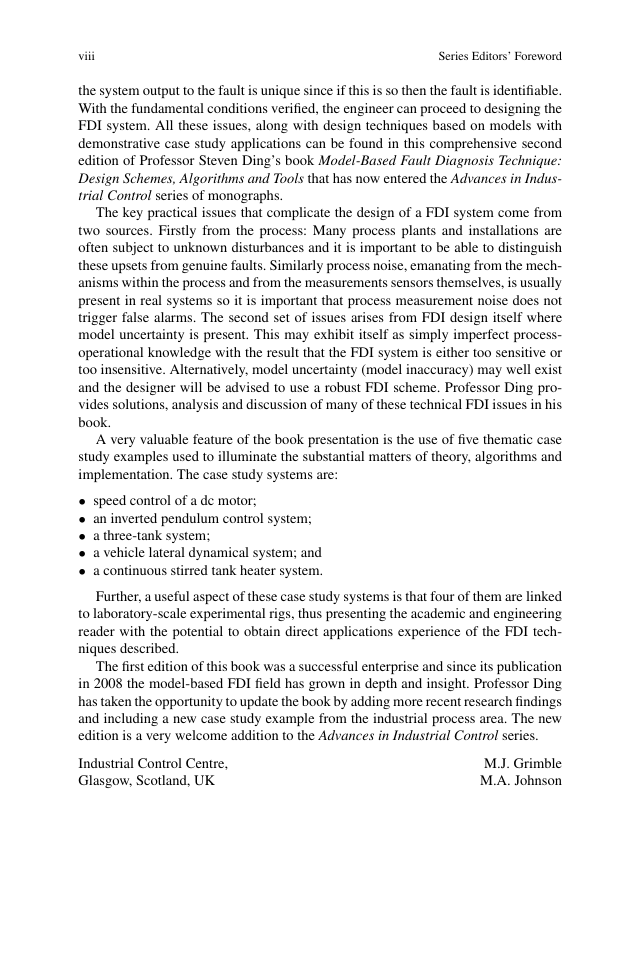
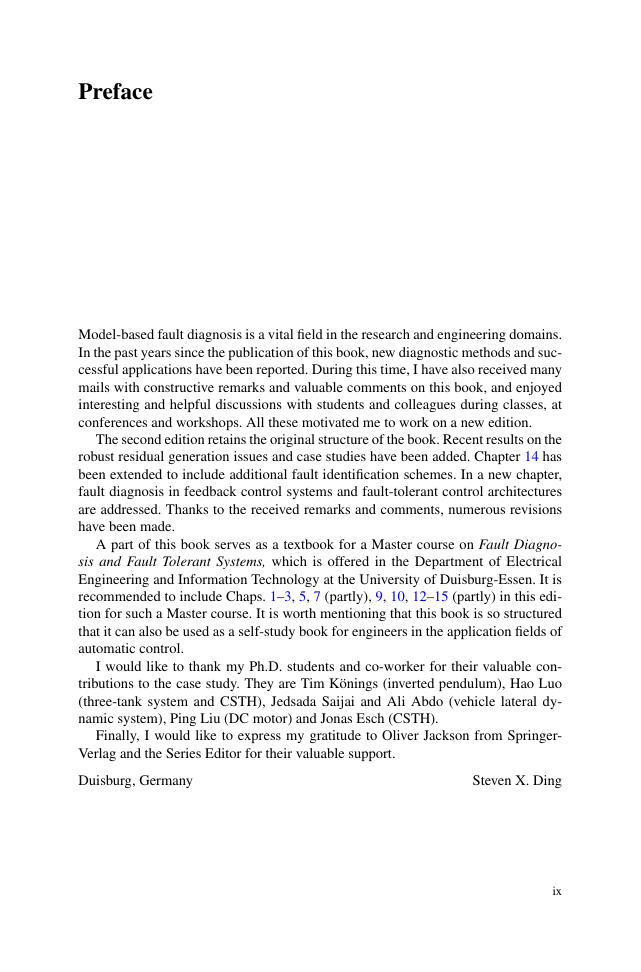
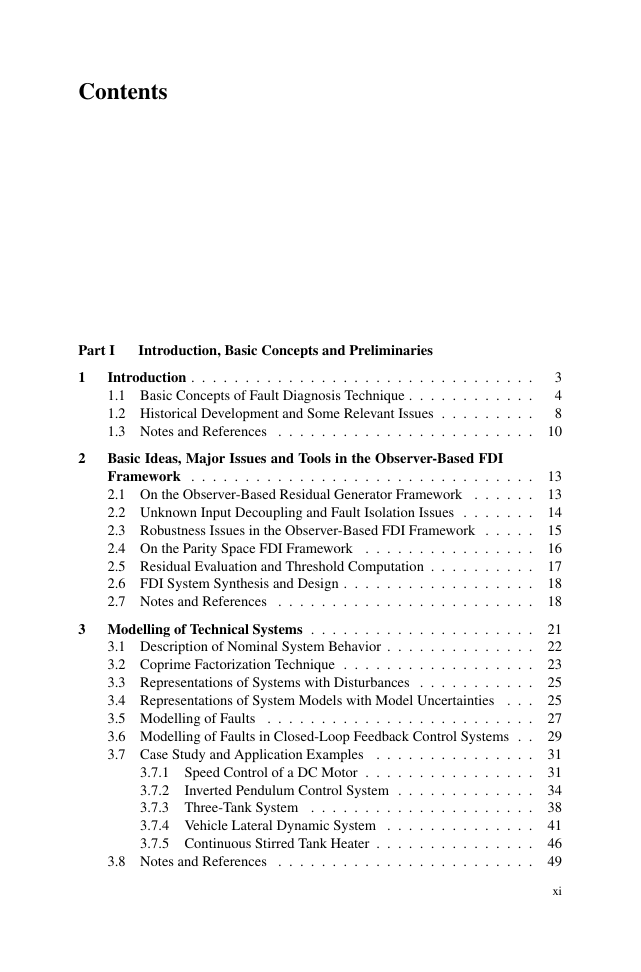








 2023年江西萍乡中考道德与法治真题及答案.doc
2023年江西萍乡中考道德与法治真题及答案.doc 2012年重庆南川中考生物真题及答案.doc
2012年重庆南川中考生物真题及答案.doc 2013年江西师范大学地理学综合及文艺理论基础考研真题.doc
2013年江西师范大学地理学综合及文艺理论基础考研真题.doc 2020年四川甘孜小升初语文真题及答案I卷.doc
2020年四川甘孜小升初语文真题及答案I卷.doc 2020年注册岩土工程师专业基础考试真题及答案.doc
2020年注册岩土工程师专业基础考试真题及答案.doc 2023-2024学年福建省厦门市九年级上学期数学月考试题及答案.doc
2023-2024学年福建省厦门市九年级上学期数学月考试题及答案.doc 2021-2022学年辽宁省沈阳市大东区九年级上学期语文期末试题及答案.doc
2021-2022学年辽宁省沈阳市大东区九年级上学期语文期末试题及答案.doc 2022-2023学年北京东城区初三第一学期物理期末试卷及答案.doc
2022-2023学年北京东城区初三第一学期物理期末试卷及答案.doc 2018上半年江西教师资格初中地理学科知识与教学能力真题及答案.doc
2018上半年江西教师资格初中地理学科知识与教学能力真题及答案.doc 2012年河北国家公务员申论考试真题及答案-省级.doc
2012年河北国家公务员申论考试真题及答案-省级.doc 2020-2021学年江苏省扬州市江都区邵樊片九年级上学期数学第一次质量检测试题及答案.doc
2020-2021学年江苏省扬州市江都区邵樊片九年级上学期数学第一次质量检测试题及答案.doc 2022下半年黑龙江教师资格证中学综合素质真题及答案.doc
2022下半年黑龙江教师资格证中学综合素质真题及答案.doc